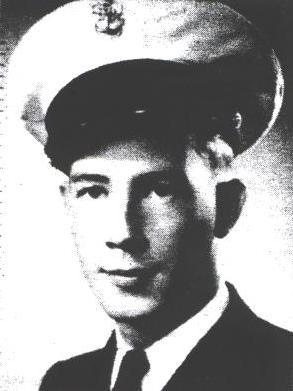Everette H. Mayes US Navy USS Pennsylvania |
It was a little before 8 a.m. on another warm Sunday in Hawaii; December 7, 1941. Everette Mayes, a crewman on the USS Pennsylvania, was taking it easy, talking with a couple of buddies and playing records. Their ship was in dry dock, undergoing repairs. Mayes, who hailed from Surry County, had already eaten breakfast and was going into Honolulu to attend worship service later in the day. Mayes had no way of knowing he was about to be submerged in history. Through the open portholes of his quarters Mayes "saw planes diving and said to the other two men, 'Wonder why they are practicing on Sunday morning?'" "Suddenly we saw the diving Japanese planes with the rising sun emblem on their wings. I said, 'This is the real thing. Dog those port holes and get to your battle stations.'" All at once on Ford Island at the air station, debris and flames began shooting what seemed like hundreds of feet high into the air," Mayes said. Ford Island, located in the middle of Pearl Harbor and the home of "Battleship Row", was the object of the heaviest bombing in the Japanese sneak attack. "As soon as we had secured our part of the ship, we were on our way to our battle stations before the officer on duty was able to get the sailor on duty with him to the sound system to sound 'man your battle station,'" Mayes said. The Pennsylvania, whose screws (propellers) had been removed and were resting on the bottom of the dock, was one of the first ships in Pearl Harbor to react, her crews hammering away at the Japanese with .50 caliber machine guns. "Some gun crews were actually at their stations and firing away before the (general quarter's alarm) was sounded. We were credited with downing two Japanese planes," Mayes said. "We were hampered in the performance of our duties due to keys not being available to get to the ammunition for the anti-aircraft batteries. In all the confusion, we were still credited with destroying two planes." The US fleet, half of which was destroyed or put out of commission by the Japanese, was caught entirely unaware by the sneak attack. Because of intercepted secret Japanese coded radio communications earlier, military leaders were aware that some hostile military action was highly possible. However, conventional wisdom held that such an attack would probably occur in the Philippines or some other likely South Pacific military target. The USS Pennsylvania received a direct medium bomb hit," Mayes explained, and was severely strafed by machine gun fire. The bomb hit the starboard side of the battleship and killed the entire five-inch gun crew. "There were several waves of planes, and the attack lasted nearly two hours," Mayes said. "If I remember correctly, we stayed at our battle stations until around noon. I do remember the cooks bringing the noon meal to us, consisting of sandwiches and fresh fruit. We lost 22 or 23 men" in the Japanese attack, he said, "with about that many more being sent to the hospital. The saddest part, along with the loss of our own men, was when we could see our fleet being sunk in Pearl Harbor and so many lives being lost." Mayes remembers particularly packing up the belongings of one close friend who was killed and sending them home to the boy's family. When the attack was finally over, the destruction in Pearl Harbor was appalling, Mayes said. The battleship Arizona was in ruins on the bottom of the harbor, only her blazing superstructure rising above the surface. Over 1,100 officers and enlisted men died on the great ship, which now is a national memorial and tomb. Loss of life was also great on the battleship Oklahoma, which capsized. For days afterwards, Navy crews cut holes in the ship's thick steel hull to rescue sailors who managed to find small air pockets. The trapped men tapped out mores code on the hull with tools to alert their rescuers. Target ship Utah, also a national memorial on the opposite side of Ford Island from the Arizona, ended up on the bottom, as did destroyers Cassin and Downes, Mayes said. Battleships West Virginia, California and Nevada were also sunk or beached, but were ultimately salvageable, he explained, as was the minesweeper Oglala. Less damaged were battleships Tennessee, Maryland, and Pennsylvania; cruisers Helena, Honolulu and Raleigh, destroyer Shaw, seaplane tender Curtiss and repair ship Vestal, Mayes said. The Tennessee and Vestal, both moored on Battleship Row, escaped with remarkable light damage. Tennessee was shielded from the burning Arizona by the West Virginia, whose deck was covered in debris and burning oil from the mortally wounded battleship. Vestal had been moored right next to Arizona while repair work was being done. Her captain got away from the battleship quickly as Japanese punishment mounted. Information provided by Everette H. Mayes |
